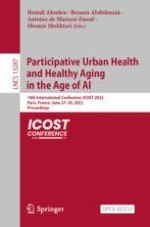1 Introduction
2 Related Research
2.1 QOL Estimation
2.2 Stress Estimation
2.3 Health Management in Smart Home
3 Proposed Method
3.1 Acquisition of Daily Living Activities
3.2 Acquisition of Stress Index
3.3 Association of Activities with Stress Indicators
3.4 Prediction Model Construction
4 Evaluation Experiment
4.1 Dataset
Time | Activity |
|---|---|
−7:00 | Sleep |
7:30–8:00 | Cook |
8:00–8:30 | Meal |
8:30–9:00 | Rest |
9:00–18:00 | Go Out |
18:00–18:30 | Cook |
18:30–19:30 | Meal |
19:30–21:00 | Rest |
21:00–21:30 | Bath |
21:30–23:00 | Rest |
23:00- | Sleep |
Activity | RRI variance | LP area |
|---|---|---|
Sleep | 0.8 | 1.0 |
Cook | 0.3 | 0.5 |
Meal | 0.2 | 0.4 |
Rest | 0.3 | 0.3 |
Go out | 0.1 | 0.3 |
Bath | 0.5 | 0.7 |
Sleep | 0.9 | 0.9 |
-
M1. Did you feel physically refreshed this morning?
-
M2. Did you feel mentally refreshed this morning?
-
N1. Do you experience any physical stress due to physical pain or discomfort?
-
N2. Do you experience mental stress?
4.2 Selection of Features and Baseline Methods
-
Average RRI value in the last 24 h
-
Standard deviation of RRI in the last 24 h
-
Average RRI for 3 h after waking up
-
Standard deviation of RRI for 3 h after waking up
-
Baseline 1 Lorenz plot area in the last 24 h
-
Baseline 2 Lorenz plot area and sleep time in the last 24 h
-
Proposed method Lorenz plot area for each activity (up to 6 types), Lorenz plot area for each activity in 3 h after waking up (up to 6 types)
4.3 Model Construction and Validation
5 Results
5.1 Effects of Different Features
5.2 Stress Estimation Model Construction
Baseline Method 1 | Baseline Method 2 | Proposed Method | |
|---|---|---|---|
M1 | 0.32 | 0.47 | 0.57 |
M2 | 0.35 | 0.49 | 0.56 |
N1 | 0.33 | 0.54 | 0.63 |
N2 | 0.38 | 0.39 | 0.57 |
baseline method1 | baseline method2 | proposed method | ||||||
|---|---|---|---|---|---|---|---|---|
accuracy | 33% | accuracy | 54% | accuracy | 63% | |||
recall | f-measure | recall | f-measure | recall | f-measure | |||
Bad | 0.34 | 0.37 | Bad | 0.53 | 0.59 | Bad | 0.63 | 0.69 |
Good | 0.35 | 0.40 | Good | 0.60 | 0.64 | Good | 0.76 | 0.70 |
Feature | Importance |
|---|---|
RRIMean | 0.119 |
Lorenz plot _Bathing | 0.114 |
RRIMean_3hour | 0.112 |
RRIStd | 0.093 |
Lorenz plot_Goingout | 0.076 |
Lorenz plot_Sleeping | 0.073 |
Lorenz plot_Eating | 0.073 |
Lorenz plot_Other_3hour | 0.065 |
Lorenz plot_Other | 0.060 |
Lorenz plot_Cooking_3hour | 0.052 |
Lorenz plot_Cooking | 0.048 |
RRIStd_3hour | 0.046 |
Lorenz plot_Eating_3hour | 0.044 |
Lorenz plot_Goingout_3hour | 0.026 |
